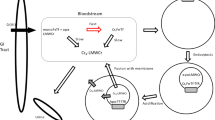Abstract
The kinetics of binding of Cu (II), Tb (III) and Fe(III) to ovotransferrin have been investigated using the stopped-flow technique. Rate constants for the second-order reaction, k +, were determined by monitoring the absorbance change upon formation of the metal-transferrin complex in time range of milliseconds to seconds. The N and C sites appeared to bind a particular metal ion with the same rate; thus, average formation rate constants k + (average) were 2.4 × 104 M−1 s−1 and 8.3 × 104 M−1 S −1 for Cu (II) and Tb (III) respectively. Site preference (N site for Cu (II) and C site for Tb (III)) is then mainly due to the difference in dissociation rate constant for the metals. Fe (III) binding from Fe-nitrilotriacetate complex to apo-ovotransferrin was found to be more rapid, giving an average formation rate constant k + (average) of 5 × 105 M−1 s−1, which was followed by a slow increase in absorbance at 465 nm. This slow process has an apparent rate constant in the range 3 s−1 to 0.5 s−1, depending upon the degree of Fe (III) saturation. The variation in the rate of the second phase is thought to reflect the difference in the rate of a conformational change for monoferric and diferric ovotransferrins. Monoferric ovotransferrin changes its conformation more rapidly (3.4s−1) than diferric ovotransferrin (0.52 s−1). A further absorbance decrease was observed over a period of several minutes; this could be assigned to release of NTA from the complex, as suggested by Honda et al. (1980).
Similar content being viewed by others
Abbreviations
- Tf:
-
ovotransferrin
- NTA:
-
nitrilotriacetate
References
Aasa R, Malmsrom RB, Saltman P, Vangerd T (1963) The specific binding of iron (III) to transferrin and conalbumin. Biochim Biophys Acta 75:203–222
Aisen P, Lang G, Woodworth RC (1973) Spectroscopic evidence between the iron-binding sites of conalbumin. J Biol Chem 248:647–653
Anderson BF, Baker HM, Dodson EJ, Norris GE, Rumball SV, Wates JM, Baker EN (1987) Structure of human lactoferrin at 3.9 A resolution. Proc Natl Acad Sci USA 84:1769–1772
Bates GW (1982) Metal ion and anion exchange reactions of serum transferrin; the role of quaternary complexes and conformational transitions: In: Saltman P, Hegenaiuer J (eds) The biochemistry and physiology of iron. Elsevier, North Holland, pp 3–18
Bates GW Schlabach MR (1973) A study of the anion binding sites of transferrin. FEBS Lett 33:289–292
Bates GW, Wernicke J (1971) The kinetics and mechanism of Iron(III) exchange between chelates and transferrin IV The reaction of transferrin with iron (II) NTA. J Biol Chem 246:3679–3685
Bezkorovainy A (1980) Chemistry and metabolism of the transferrin In: Biochemistry of nonheme iron. Plenum Press, New York, pp 127–206
Brock JH (1985) Transferrins. In: Harrison P (ed) Topics in molecular and structural biology, vol 7. Verlag Chemie, Weinheim Basel, pp 178–261
Cowart RE, Kojima N, Bate GW (1982) The exchange of Fe3+ between acetohydroxamic acid and transferrin. Spectrophotometric evidence for a mixed ligand complex. J Biol Chem 257:7560–7565
Donovan JW, Ross KD (1975) Non equivalence of the metal binding sites of conalbumin. J Biol Chem 250:6022–6025
Feeney RE, Komatsu StK (1966) The transferrins. Struct Bond 1:149–206
Frankel-Conrat H, Feeney RE (1950) The metal-binding activity of conalbumin. Arch Biochem 29:101–113
Glazer AN, McKenzie HA (1963) The denaturation of proteins IV. Conalbumin and iron (III)-conalbumin in urea solution. Biochim Biophys Acta 71:109–123
Gorinsky B, Horsburgh C, Lindley PC, Moss DS, Parker M, Watoson JL (1979) Evidence for the bilobal nature of diferric rabbit plasma transferrin. Nature 281:157–158
Harris DC, Aisen P (1973) Facilitation of Fe(II) autoxidation by Fe(III) complexing agents. Biochim Biophys Acta 329: 156–158
Honda K, Nishikata I, Sasakawa S (1980) Kenetics of specific binding of iron (III)-NTA to human apotransferrin and of the ligand exchange of the resulting complex using the stopped-flow technique. Chem Lett (Jpn) 1980:21–24
Ichimura K, Kihara H, Yamamura T, Satake K (1989) Negative cooperativity of chicken ovotransferrin on AI(III)-binding. J Biochem 106:50–54
Luk CK (1971) Study of the nature of the metal-binding sites and estimate of the distance between the metal-binding sites in transferrin using trivalent lanthanide ions as fluorescent probes. Biochemistry 10:2838–2843
Metz-Boutigue M-H, Jolles J, Mazurier J, Schoentgen F, Legrand D, Spik G, Montreuil J, Jolles P (1984) Human lactotransferrin: Amino acid sequence and structural comparisons with other transferrins. Eur J Biochem 145:659–676
Nelder JA, Mead R (1964) A simplex method for function minimization. Comput J 5:308–313
Tan AT, Woodworth RC (1969) Ultraviolet difference spectral studies of conalbumin complexes with transition metal ions. Biochemistry 8:3711–3716
Warner RC, Weber I (1951) The preparation of crystalline conalbumin. J Biol Chem 191:173–180
Williams J, Elleman TC, Kingston IB, Wilkina AG, Kuhn KA (1982) The primary structure of hen ovotransferrin. Eur J Biochem 122:297–303
Yamamura T, Hagiwara S, Nakazato K, Satake K (1984) Copper complexes at N- and C-site of ovotransferrin: quantitative determination and visible absorption spectrum of each complex. Biochem Biophys Res Commun 119:298–304
Yamamura T, Ikeda H, Nakazato K, Takimura K, Satake K (1985) “Cooperativity between the N and C domains of ovotransferrin observed on iron binding and thermal denaturation”. In: Spik G, Montreuil J, Crichton RR, Mazurier (eds) Proteins of iron storage and transport. Elsevier, Amsterdam, pp 53–56
Yamamura T, Ichimura K, Hayashi A, Tsuda T, Taniguchi T, Toi R, Kawashima S, Maeda Y, Kihara H, Satake K (1988) Lanthanoid complex of iron-transport protein, transferrin. Kinetic study on release of the metal from N and C binding sites. Nippon kagaku kaishi (in Japanese) 1988:452–458
Yang F, Lum JB, McGill JR, Moore CM, Naylor SL, van Bragt PH, Baldwin WD, Bowman BH (1984) Human transferrin: cDNA characterization and chromosomal localization. Proc Natl Acad Sci USA 81:2752–2756
Author information
Authors and Affiliations
Additional information
Jichi Medical School, School of Nursing, Yakushiji 3311-159, Minamikawachi, Tochigi, 329-04 Japan
Rights and permissions
About this article
Cite this article
Taniguchi, T., Ichimura, K., Kawashima, S. et al. Binding of Cu (II), Tb (III) and Fe (III) to chicken ovotransferrin. Eur Biophys J 18, 1–8 (1990). https://doi.org/10.1007/BF00185414
Received:
Accepted:
Issue Date:
DOI: https://doi.org/10.1007/BF00185414




